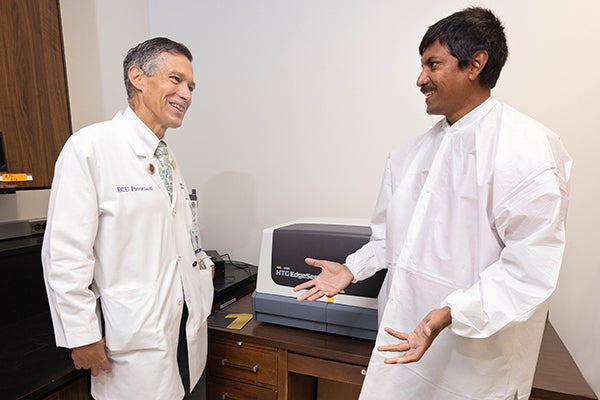ECU research study aims to unravel secrets of human gene expression
A pair of researchers at East Carolina University’s Brody School of Medicine have received $280,000 in funding from Janssen Pharmaceuticals to study the way that genes are expressed in humans, and possibly gain a better understanding of how to engineer medicines to target diseases in novel ways without life-altering side effects.
Dr. Paul Cook, chief of Brody’s Division of Infectious Diseases, and Dr. Shaw Akula, associate professor of microbiology and immunology, have been working together so long that they have a created a shorthand, of sorts: Akula comes up with a research idea while Cook makes it clinically relevant and they move forward together to get a study proposal funded.

East Carolina University’s Dr. Paul Cook and Dr. Shaw Akula discuss microRNA in a lab at the Brody School of Medicine. (Photo by Cliff Hollis)
The arrangement has led to several studies that the pair have partnered on including a recently awarded grant-funded study to tease out the secrets of microRNAs — tiny ribonucleic acid (RNA) strands regulating gene expression and function.
“Doctor Akula approached me two years ago when we started seeing a lot of COVID and said that we should look at these microRNAs,” Cook said. “I had heard of messenger RNAs, but when I went to medical school microRNAs weren’t known.”
And they still aren’t, really. MicroRNAs are small pieces of RNA material that are found in animals, plants and some viruses and control how the body’s genes are expressed — if you have dark skin or light, are tall or short, curly hair or strait.
“If genes are the instruments in a symphony, the microRNA might be the conductor, telling what genes to make sound and which to be silent to play a song the way it was written,” Akula said. In their study, Akula said they are “going to the top of the cascade” to find how genetic expression is controlled.
Early in the COVID-19 pandemic, Akula and Cook studied the differences in microRNA samples between healthy, uninfected subjects and patients who had been admitted to the hospital with severe cases of COVID-19. Cook and Akula were able to correlate the RNA changes in COVID-19 infected individuals with an increase in mortality. In short, it seemed the disease affected the patient’s microRNAs, changing the way the body responded to disease.
This got the two men thinking about how else changes in microRNAs might affect the body.
Cook saw his first HIV-infected patient in 1983 — early in the progress of that pandemic. Over past three decades, research into HIV created a number of drugs that make living with HIV a chronic illness rather than a short-term death sentence.
“At that time we had no therapy. Now we have a lot of medicines and they work pretty good,” Cook said.
People aren’t dying from HIV anymore, Cook said, but from other causes.
Medications that treat HIV come in two broad categories in terms of side effects: some drugs cause weight gain and other drugs don’t. Medical researchers have their suspicions about why some drugs target protease inhibitors and some target integrase inhibitors (two aspects of cell function). The question remained about why the two drugs were so starkly different in causing weight gain as a side effect. Cook said that previous studies have been retrospective, meaning that researchers “looked back and saw the patients gain weight, and then they looked at the drugs they were taking and said, ‘Man, this is associated with this drug.’”
Retrospective studies can lead to hypotheses about the cause of a condition but aren’t exacting enough to draw actionable conclusions from.
Cook and Akula thought microRNAs might be the root cause and devised a study to test the two different types of medications in HIV patients and then see what changes might take hold in the patients’ microRNA.
One of the challenges is to control for diet. Dr. Laura Materese, a nutritionist at the Brody School of Medicine, was enlisted to help work through the variables, primarily caloric intake, which will be accounted for with a smart phone app that trial participants will use to track their daily food consumption.
The goal of the study then is to determine why some medications are associated with weight gain and others aren’t.
“The idea is, if you determine these microRNAs that are associated with weight gain, then you can target them,” Cook said.
And if you can target the weight-gain-causing microRNAs, then researchers have a good chance of learning how to target many of the microRNAs that direct the function of the whole body.
The end goal, Akula said, is to better understand how microRNAs work to create better RNA interference — also known as RNAi — therapies that currently target lesser-known diseases. The discovery of the RNAi mechanism led to its discoverers being awarded the Nobel Prize in Medicine in 2006.
“The results of the study aren’t expected for more than a year because tracking any weight gain that might occur as a result of the medications won’t happen overnight,” Cook said.